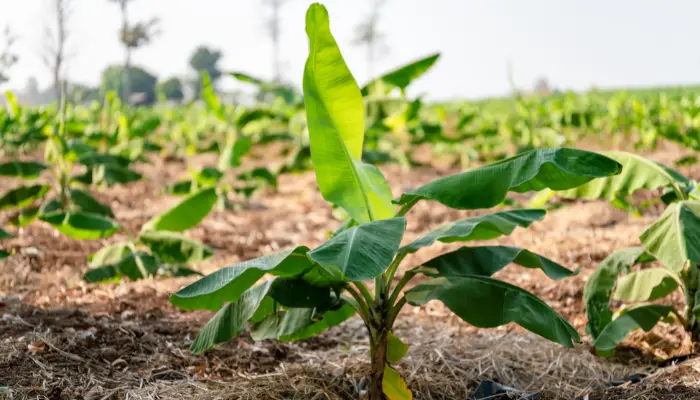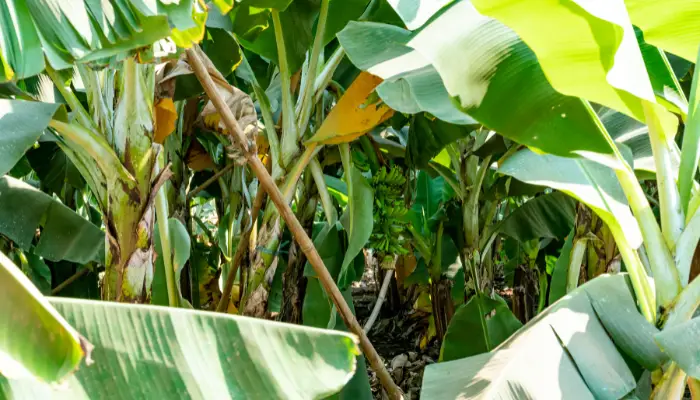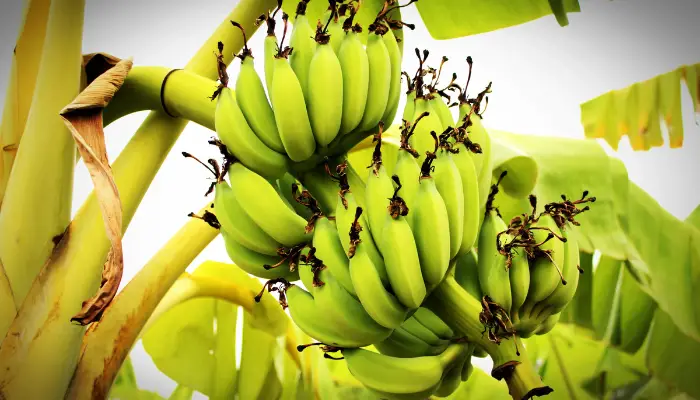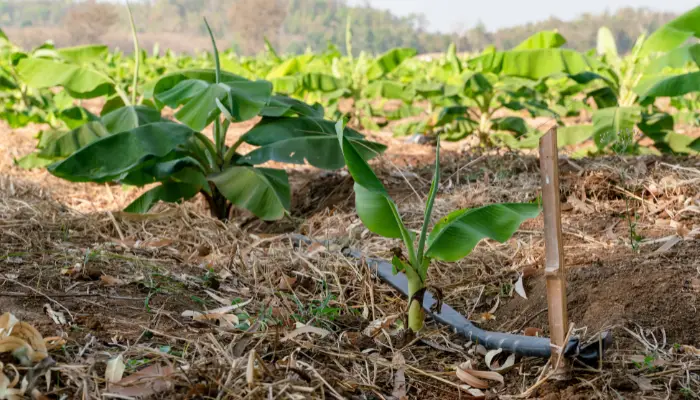Intriguing plants with particular growing conditions, bananas are native to tropical regions of India, Southeast Asia, and northern Australia; the Portuguese brought them to South America in the early 16th century, and they are grown in tropical regions all over the world today, from South and Central America to India, China, and Africa. Bananas are a staple food for many people worldwide and a favorite snack for others.

What Climate Do Bananas Grow In
The Ideal Climate for Bananas
Banana plants thrive in warm and wet conditions, along with fertile soils. They grow best in the tropics, with an average temperature in the high-20s Celsius. They can be found in plantations in a wide band between 30 degrees north and south of the equator.
Bananas prefer steady warmth, not too hot and not too cold. They are sensitive to temperatures and can be considered sissies when it comes to temperature fluctuations. They also require steady moisture, both in the ground and in the air
Soil Requirements
Bananas like rich, dark, fertile soils. They require lots of mulch and organic matter. Nitrogen and potassium are essential nutrients for their growth, and chicken manure is a good source of these.
Other Growing Conditions
Banana plants dislike strong winds, extreme heat or cold, and being hungry or thirsty. They also do not like being alone and exposed. They prefer the shelter of other bananas, which is often overlooked by home growers.
Varieties of Bananas
There are a few different types of bananas, but the two most popular ones are Lady Finger and Cavendish. Lady Finger is the type of banana you usually find in the grocery store; it is a tall, slender plant with smaller, sweeter fruit; gardeners grow it mostly for its small fruit as an added bonus. Plantains are the bananas used in cooking; they are starchy and drier.

Common Pests and Diseases That Affect Bananas?
Banana plants can be affected by a variety of pests and diseases. Here are some of the most common ones:
Pests:
- Nematodes: They are a widespread pest of banana plants, causing the corms to decay and serving as a vector for the fungus Fusarium oxysporum.
- Weevils: The black weevil (Cosmopolites sordidus) or banana stalk borer, banana weevil borer, or corm weevil is the second most destructive pest. Black weevils tunnel upward and attack the pseudostem’s base.
- Thrips: Banana rust thrips (Chaetanaphothrips signipennis) stain the peel, causing it to split and expose the flesh which then begins to rot.
Diseases:
- Fungal diseases: Bananas can be affected by various fungal diseases.
- Bacterial diseases: There are also several bacterial diseases that can affect banana plants.
- Viral diseases: Viral diseases can also pose a threat to banana plants.
How to Prevent Pests and Diseases in Banana Plants?
To prevent pests and diseases in banana plants, consider the following strategies:
- Cultural Practices: Maintain good farm hygiene, use proper irrigation and drainage, and ensure adequate spacing between plants to reduce the risk of disease spread.
- Resistant Varieties: Choose banana varieties that are resistant to common pests and diseases in your area.
- Regular Monitoring: Keep a close eye on your plants for early signs of infestation or disease, and take prompt action if needed.
- Integrated Pest Management (IPM): Use a combination of biological control agents, cultural practices, and chemical treatments as necessary, while minimizing harm to the environment.
These methods can help create a robust defense against the common challenges faced by banana growers. Remember, prevention is key to maintaining healthy banana plants.
How Long Does it Take For a Banana Plant to Produce Fruit?

Banana plants typically take about 9 to 12 months to produce their first fruit in tropical and subtropical regions. However, the time can vary depending on factors such as climate, soil condition, and variety. In cooler climates where fruiting is not as rapid, it can take up to 3 years for the first bunch of bananas to be produced. While some home-grown banana plants can provide several bunches of fruit each year, most only yield one or two fruit bunches; each bunch can contain up to 200 bananas. Please note that these are estimations and that the real time may differ depending on certain circumstances.
How To Know When My Banana Plant is Ready to Produce Fruit?
A banana plant is ready to produce fruit once it is fully mature, which typically takes between 9 and 15 months. The first sign of fruiting is the appearance of flowers, which are fairly large and an interesting shade of dark purple. The female flowers, which are the ones that develop fruits, are the first to appear in mid- to late-spring, however they can also form in early summer if you had a late winter.
After the female flowers are pollinated, bananas take three to four months to form. Depending on when your tree started to flower, this means that your bananas will be ready to harvest in late summer or early fall. Growing times can also differ between different varieties of bananas, so be sure to know which one you are growing.
To support development, blooming, and fruit production, make sure your banana plant receives at least 12 hours of sunlight each day. Water it deeply and thoroughly on a regular basis to keep the soil moist.
Conclusion
In conclusion, bananas are a tropical fruit that requires specific growing conditions. They thrive in warm, wet climates with fertile soils. Understanding these conditions can help ensure a successful banana harvest, whether you’re a commercial grower or a home gardener.
Frequently Asked Questions About Banana Growth Climates
1. Can bananas grow in temperate climates?
Bananas are primarily tropical plants and thrive in warm, humid conditions. They cannot tolerate frost, making temperate climates unsuitable for their cultivation.
2. What is the ideal temperature range for banana growth?
Bananas prefer temperatures between 80 to 95 degrees Fahrenheit (27 to 35 degrees Celsius). They are extremely sensitive to cold and cannot survive in temperatures below 50 degrees Fahrenheit (10 degrees Celsius).
3. Do bananas require a lot of rainfall?
Yes, bananas need consistent moisture for optimal growth. Regions with annual rainfall between 78 to 98 inches (2,000 to 2,500 millimeters) are considered ideal for banana cultivation.
4. Can bananas tolerate dry periods?
While bananas can tolerate short dry spells, prolonged droughts can negatively impact their growth and yield. Adequate water supply is crucial for their overall health.
5. What type of soil is best for growing bananas?
Bananas thrive in well-draining, fertile soil with a slightly acidic to neutral pH. Sandy loam or loamy soil with good water retention capabilities is ideal for banana cultivation.
6. Are there varieties of bananas that can grow at higher altitudes?
Yes, some banana varieties, like the Highland Banana, are adapted to higher altitudes ranging from 2,000 to 6,000 feet (600 to 1,800 meters) above sea level. These varieties can tolerate cooler temperatures.
7. Which countries are major producers of bananas?
Countries with tropical climates near the equator, such as Ecuador, the Philippines, Costa Rica, and Honduras, are major producers of bananas. These regions provide the necessary conditions for large-scale banana plantations.
8. What challenges do banana crops face?
Banana crops are susceptible to diseases like Panama disease, caused by the Fusarium fungus. Pests and changing climate patterns, including extreme weather events, also pose challenges to banana cultivation.
9. How can sustainable banana cultivation be promoted?
Sustainable banana cultivation involves implementing practices that reduce environmental impact, such as using organic farming methods, conserving water, and adopting disease-resistant varieties. Supporting fair trade initiatives also contributes to the sustainability of banana production.
10. How does climate change affect banana cultivation?
Climate change can impact banana cultivation by altering temperature and precipitation patterns, increasing the risk of diseases and pests, and causing extreme weather events. Research and adaptation strategies are essential to address these challenges and ensure the resilience of banana crops.




